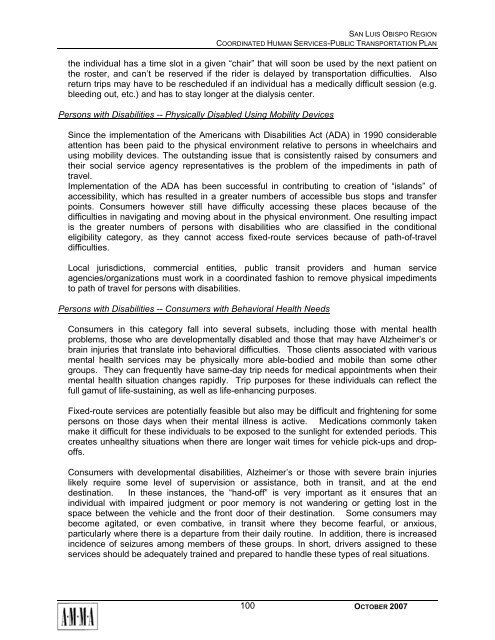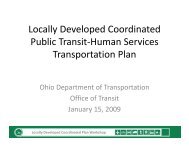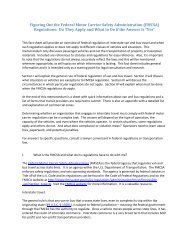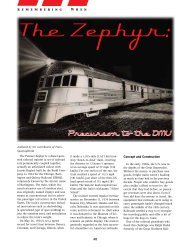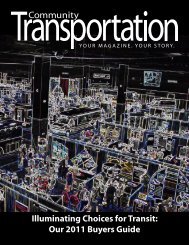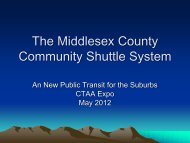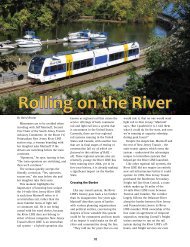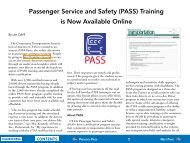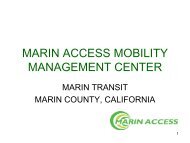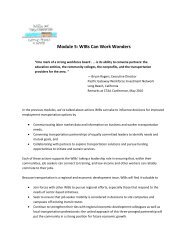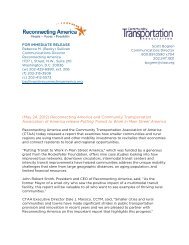San Luis Obispo - Caltrans - State of California
San Luis Obispo - Caltrans - State of California
San Luis Obispo - Caltrans - State of California
Create successful ePaper yourself
Turn your PDF publications into a flip-book with our unique Google optimized e-Paper software.
SAN LUIS OBISPO REGION<br />
COORDINATED HUMAN SERVICES-PUBLIC TRANSPORTATION PLAN<br />
the individual has a time slot in a given “chair” that will soon be used by the next patient on<br />
the roster, and can’t be reserved if the rider is delayed by transportation difficulties. Also<br />
return trips may have to be rescheduled if an individual has a medically difficult session (e.g.<br />
bleeding out, etc.) and has to stay longer at the dialysis center.<br />
Persons with Disabilities -- Physically Disabled Using Mobility Devices<br />
Since the implementation <strong>of</strong> the Americans with Disabilities Act (ADA) in 1990 considerable<br />
attention has been paid to the physical environment relative to persons in wheelchairs and<br />
using mobility devices. The outstanding issue that is consistently raised by consumers and<br />
their social service agency representatives is the problem <strong>of</strong> the impediments in path <strong>of</strong><br />
travel.<br />
Implementation <strong>of</strong> the ADA has been successful in contributing to creation <strong>of</strong> “islands” <strong>of</strong><br />
accessibility, which has resulted in a greater numbers <strong>of</strong> accessible bus stops and transfer<br />
points. Consumers however still have difficulty accessing these places because <strong>of</strong> the<br />
difficulties in navigating and moving about in the physical environment. One resulting impact<br />
is the greater numbers <strong>of</strong> persons with disabilities who are classified in the conditional<br />
eligibility category, as they cannot access fixed-route services because <strong>of</strong> path-<strong>of</strong>-travel<br />
difficulties.<br />
Local jurisdictions, commercial entities, public transit providers and human service<br />
agencies/organizations must work in a coordinated fashion to remove physical impediments<br />
to path <strong>of</strong> travel for persons with disabilities.<br />
Persons with Disabilities -- Consumers with Behavioral Health Needs<br />
Consumers in this category fall into several subsets, including those with mental health<br />
problems, those who are developmentally disabled and those that may have Alzheimer’s or<br />
brain injuries that translate into behavioral difficulties. Those clients associated with various<br />
mental health services may be physically more able-bodied and mobile than some other<br />
groups. They can frequently have same-day trip needs for medical appointments when their<br />
mental health situation changes rapidly. Trip purposes for these individuals can reflect the<br />
full gamut <strong>of</strong> life-sustaining, as well as life-enhancing purposes.<br />
Fixed-route services are potentially feasible but also may be difficult and frightening for some<br />
persons on those days when their mental illness is active. Medications commonly taken<br />
make it difficult for these individuals to be exposed to the sunlight for extended periods. This<br />
creates unhealthy situations when there are longer wait times for vehicle pick-ups and drop<strong>of</strong>fs.<br />
Consumers with developmental disabilities, Alzheimer’s or those with severe brain injuries<br />
likely require some level <strong>of</strong> supervision or assistance, both in transit, and at the end<br />
destination. In these instances, the “hand-<strong>of</strong>f” is very important as it ensures that an<br />
individual with impaired judgment or poor memory is not wandering or getting lost in the<br />
space between the vehicle and the front door <strong>of</strong> their destination. Some consumers may<br />
become agitated, or even combative, in transit where they become fearful, or anxious,<br />
particularly where there is a departure from their daily routine. In addition, there is increased<br />
incidence <strong>of</strong> seizures among members <strong>of</strong> these groups. In short, drivers assigned to these<br />
services should be adequately trained and prepared to handle these types <strong>of</strong> real situations.<br />
100<br />
OCTOBER 2007


